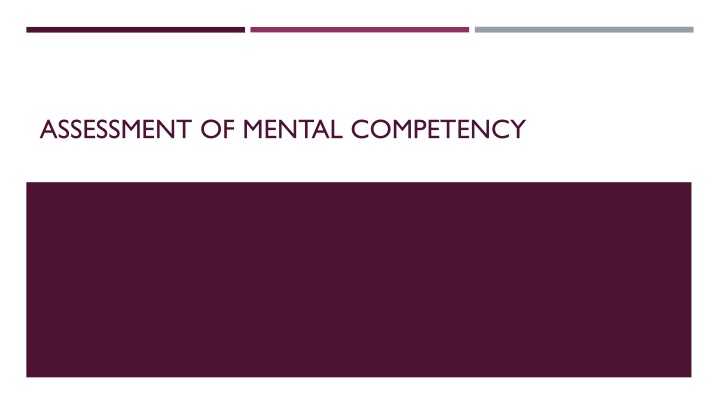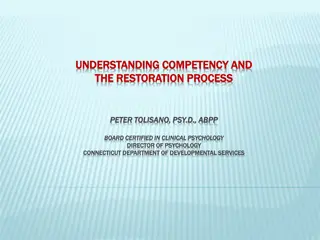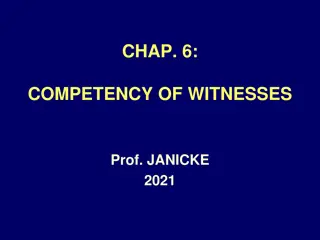
Mental Competency and Evaluation in Law
Learn about mental competency in the legal context, including its definition, evaluation process, and tests used. Explore the importance of intelligent tests and the historical significance of Alfred Binet and Theodore Simon in the development of intelligence testing.
Download Presentation

Please find below an Image/Link to download the presentation.
The content on the website is provided AS IS for your information and personal use only. It may not be sold, licensed, or shared on other websites without obtaining consent from the author. If you encounter any issues during the download, it is possible that the publisher has removed the file from their server.
You are allowed to download the files provided on this website for personal or commercial use, subject to the condition that they are used lawfully. All files are the property of their respective owners.
The content on the website is provided AS IS for your information and personal use only. It may not be sold, licensed, or shared on other websites without obtaining consent from the author.
E N D
Presentation Transcript
WHAT IS MENTAL COMPETENCY ? In law, it means having a basic knowledge of the court proceedings. Ability of a person to be rational, to express themselves and fitness to be able to give testimony in court or understand the trial proceedings. A defendant should understand who the courtroom players are, meaning the judge, prosecutor, and the jury. He should understand what he is being charged with and what the possible consequences can be.
MENTAL COMPETENCY EVALUATION Every courtroom has the authority to order a psychological evaluation for the defendant. It is typically the defendant's attorney who initially declares the client as incompetent. and judge will use the evaluation results to make his decision. The evaluations are conducted by a forensic psychologist or psychiatrist. The evaluation is composed of a battery of tests and interviews to determine competency. Detailed report includes important information like the type of disability/mental illness and its description and the psychiatrist opinion.
TESTS USED IN ASSESSMENT Thematic Apperception Test (TAT) Achievement and Aptitude Tests Intelligent Tests Personality Tests The Rorschach Test House, Tree Person Test (HTP) The kinetic Family Drawing Beck s Depression inventory Neuropsychological Tests
INTELLIGENT TESTS Measures person s ability to use verbal and non verbal concepts to understand the world around him and use this information to achieve his goals. These tests are of great value to the forensic scientist to find out if The crime that was committed by the person concerned was done at all with competence. Could he have planned it intelligently and systematically etc. IQ provides the information that the accused might have planned a felony because of his high level intelligence. E.g of IQ tests : Wechsler IQ scales, Stanford BinetTest, Raven s coloured Progressive matrices, pencil- paper tests.
ALFRED BINETANDTHEODORE SIMON In 1904, a French psychologist Alfred Binet andTheodore Simon were commissioned by the French government to identify slow learners in class to benefit from remedial help. They developed the intelligence test that was designed to predict academic success. The test provided a known as intelligence quotient,or IQ. The IQ is calculated by , IQ= MA/CA X 100 A child who passed all items on the test of 8 year old gets a mental age of 8 where as the actual age of the child may be 6years.
ACHIEVEMENT APTITUDE TESTS Typically used for educational and employment requirements. Measures the knowledge of a person about a certain topics such as spellings, mathematics etc. Not used as a routine on accused. E.g. Differential Aptitude test, Need for Achievement Test
PERSONALITY TESTS Measure a person s way of dealing with different aspects and experiences of his or her life. Measure Personality traits such as extraversion, introversion, neuroticism etc. Provides information about the defenses that a person uses in dealing with life s problem. Eg. MMPI Test
MMPI TEST Minnesota Multiphasic Personality Inventory, tests are used to help diagnose mental health disorders. MMPI-2 consists of 567 true-false questions and takes approximately 60 to 90 minutes to complete, while the MMPI-2-RF has 338 true-false questions, taking 35 to 50 minutes to finish. The MMPI should only be administered by a trained test administrator. After the computer scores the test results, the psychologist writes up a report interpreting the test results in the context of the person s history and current psychological concerns.
MMPI MMPI evaluations are sometimes used in child custody disputes, substance abuse programs, educational settings, and even employment screenings. The test items on the MMPI are designed to find out where you are on ten different mental health scales. Each scale relates to a different psychological pattern or condition. The MMPI-2 is designed with 10 clinical scales which assess 10 major categories of abnormal human behavior, and four validity scales, which assess the person s general test-taking attitude and whether they answered the items on the test in a truthful and accurate manner.
THE 10 CLINICAL SUBSCALES OF THE MMPI-2 Hypochondriasis (Hs) This scale contains 32 items and is designed to measure whether you have an unhealthy concern for your own health. Depression (D) The Depression scale measures clinical depression, which is characterized by poor morale, lack of hope in the future, and a general dissatisfaction with one s life. The scale contains 57 items. Hysteria (Hy) The Hysteria scale primarily measures five components poor physical health, shyness, cynicism, headaches and neuroticism. The subscale contains 60 items. Psychopathic Deviate (Pd) Its 50 items measure antisocial behaviours and attitudes, in addition to compliance or resistance to authority. Masculinity/Femininity (Mf) The original purpose of this 56-question test section was to elicit information about people s sexuality. It stems from a time in which some mental health professionals viewed same-sex attraction as a disorder. Today, this scale is used to evaluate how consistently you seem to identify with gender norms.
Paranoia (Pa) This scale was originally developed to identify individuals with paranoid symptoms such as suspiciousness, feelings of persecution, grandiose self-concepts, excessive sensitivity, and rigid attitudes.This scale has 40 items. Psychasthenia (Pt) -The Psychasthenia scale is intended to measure a person s inability to resist specific actions or thoughts, regardless of their maladaptive nature. Psychasthenia is an old term used to describe what we now call obsessive-compulsive disorder (OCD), or having obsessive-compulsive thoughts and behaviors. This scale contains 48 items. Schizophrenia (Sc) This 78-item scale is intended to show whether you have, or are likely to develop, a schizophrenia disorder. It considers whether you re experiencing hallucinations, delusions, or bouts of extremely disorganized thinking. It also determines to what degree you may feel alienated from the rest of society. Hypomania (Ma) This scale was developed to identify characteristics of hypomania such as elevated mood, hallucinations, delusions of grandeur, accelerated speech and motor activity, irritability, flight of ideas, and brief periods of depression. This scale contains 46 items. 0.Social Introversion (Si) The Social Introversion scale measures the social introversion and extroversion of a person. A person who is a social introvert is uncomfortable in social interactions and typically withdraws from such interactions whenever possible. They may have limited social skills, or simply prefer to be alone or with a small group of friends. This scale has 69 items.
VALIDITY SCALES (MMPI 2) F detect attempts at over reporting. People who score high on this scale are trying to appear worse than they really are,. They may be in severe psychological distress, or just randomly answering questions without paying attention to what the questions say. The scale contains 60 items. Lie (L) The Lie scale. The scale contains 15 items. People who score high might be trying to present themselves in positive light by refusing to acknowledge traits or responses they fear could make them look bad. K These 30 test items focus on self-control and relationships. Like the L scale, items on the K scale are designed to highlight a person s need to be seen positively. Fb The Back F scale measures the same issues as the F scale, except only during the last half of the test. The scale has 40 items.
PROJECTIVE PERSONALITY TESTS Psychoanalytic personality theorists have developed several assessment measures known as projective tests. They include a variety of methods in which ambiguous stimuli, such as pictures of people, or things are presented to a person who is asked to describe what he or she sees. The theory here is that people `project'their own personality, their needs, their wishes, their desires and their unconscious fears and things such as ink blots, pictures, sometimes vague and sometimes structure. E.g .Rorschach Ink Blot Test, the Thematic Apperception Test (TAT), House Tree Person(HTP) and the Rotter's Incomplete Sentence Blank (RISB).
THE RORSCHACH TEST Also known as Rorschach inkblot test. Projective test, consist of 10 ambiguous pictures of which 5 are colored and 5 are B/W. There is no specific meaning for inkblots. Examinees can say whatever they perceive from pictures. Responses are noted down verbatim, and areas which produced the response are marked in sheet. Responses are then scored as per instructions given in manual and interpretations are carried out.
THEMATIC APPERCEPTION TEST (TAT) Developed by American psychologists Henry A. Murray and Christina D. Morgan at Harvard University in the 1930s. Involves showing people a series of picture cards depicting a variety of ambiguous characters (that may include men, women, and/or children), scenes, and situations. They are then asked to tell as dramatic a story as they can for each picture presented, including: what has led up to the event shown what is happening in the scene the thoughts and feelings of characters the outcome of the story
Unravel the intra psychic conflicts and helps in understanding the need of the individual, gratification and the obstacles in gratifying., The complete version includes 31 cards. Murray originally recommended using approximately 20 cards. Today, many practitioners only utilize between 5 and 12 cards, often selected because the examiner feels that the scene matches the client's needs and situation. The TAT is often criticized for not being standardized, meaning there are no rules of administration or formal scoring system. Clinicians often vary in how they administer the test. Even if clinicians use the same scoring system, they may use different cards or a different number of cards. This makes it incredibly difficult to obtain estimates of reliability and validity and almost impossible to compare results.
HOUSE, TREE, PERSON TEST (HTP) Designed by John Buck and was originally based on the Goodenough scale of intellectual functioning. In the HTP, the test taker is asked to draw houses, trees, and persons, and these drawings provide a measure of self-perceptions and attitudes. It has flexible and subjective administration and interpretation. Once the subject is done, he is asked to describe the pictures that he has done. The assumption is that when the subject is drawing he is projecting his inner world onto the page. A 350-page manual was written by Buck to instruct the test-giver on proper grading of the HTP, which is more subjective than quantitative Test is administered as part of a series of personality and intelligence tests, like the Rorsasch, TAT , Bender and Wechsler tests. The examiner integrates the results of these tests, creating a basis for evaluating the subject's personality from a cognitive, emotional , intra- and interpersonal
Takes approximately 150 minutes to complete based on the subject's level of mental functioning. During the first phase, the test-taker is asked to draw the house, tree, and person and the test-giver asks questions about each picture. There are 60 questions originally designed by Buck but art therapists and trained test givers can also design their own questions, or ask follow up questions. This phase is done with a crayon. During the second phase of HTP, the test-taker draws the same pictures with a pencil or pen. Again the test-giver asks similar questions about the drawings. Note: some mental health professionals only administer phase one or two and may change the writing instrument as desired. Variations of the test may ask the person to draw one person of each sex, or put all drawings on the same page.
Examples of follow up questions: After the House: Who lives here? Is the occupant happy? What goes on inside the house? What's it like at night? Do people visit the house? What else do the people in the house want to add to the drawing? After the Tree: What kind of tree is this? How old is the tree? What season is it? Has anyone tried to cut it down? What else grows nearby? Who waters this tree? Trees need sunshine to live so does it get enough sunshine? After the Person is drawn: who is the person? How old is the person? What do they like and dislike doing? Has anyone tried to hurt them? Who looks out for them?
THE HOUSE-TREE-PERSON TEST INTERPRETATION The house-tree-person test is based on the idea that drawings reflect feelings. The details of a drawing are seen as representations of various personality traits. Drawing a house : The house is considered being the expression of the respondent's family relations and family values. The roof stands for the intellectual side and spiritual life of the individual. The walls might be related to the test taker s character strength. The doors and windows represent the individual s relationship to the outside world and the level of social integration.
Drawing a tree: The tree is thought to suggest the deepest, unconscious aspects of the personality. The trunk is often seen as a representation of inner strength. The tree crown stands for ideas, thoughts, and self-concept. Drawing a person : The person is a symbolic representation of the ideal self and one s social interactions. The head symbolizes intelligence, communication, and imagination. The eyes indicate the perception of the world. The hands give information about affectivity and aggressiveness.
OTHER ASPECTS OF DRAWINGS Dimensions of objects : indicate the level of self-esteem and confidence. A very small house, for example, might show the individual s dissatisfaction with life at home. Level of detail : The level of detail is another revealing factor in outlining the respondent s personality through drawing. A very detailed face might indicate a need to present oneself in a favorable social light. On the contrary, pictures lacking details often indicate depression. The branches may show the degree of social connectedness. A tree with no branches indicates, for instance, that the person has little contact with others.
Location of objects : The location of objects on the page is also charged with significance. Drawings close to the top of the page are considered being related to dreams and imagination, while the ones at the bottom are connected to the physical world. Drawing on the right side of the page is linked to the future, in the center are related to the present, and left to the past. Strokes and lines : The pressure, firmness, and solidity of strokes and lines indicate determination and decision-making facilities. The same line drawn twice shows insecurity, dissatisfaction, or perfectionism. Emotional strength, high self-esteem and confidence, on the contrary, are reflected in the firmness of the lines. Test taker s attitude : In addition to all of the above elements, therapists also consider the test taker s attitude, words, and gestures while drawing. Any display of frustration, anger, or satisfaction is taken into account in test analysis.
THE HOUSE-TREE-PERSON TEST SCORING Can be scored either in an objective quantitative or subjective qualitative manner. Trained therapists rely on John Buck s comprehensive 350-page manual and interpretive guide in administering and scoring the HTP tests. Quantitative scoring provides a general assessment of intelligence. Research shows that the quantitative assessment correlates highly with other well-established intelligence tests.
REFERENCES https://www.healthline.com/health/mmpi-test#takeaway https://www.verywellmind.com/what-is-the-minnesota-multiphasic-personality-inventory-2795582#10-clinical- scales https://psychcentral.com/lib/minnesota-multiphasic-personality-inventory-mmpi#MMPI-2-RF https://zeepedia.com/read.php?assessment_of_personality_advantages_of_mmpi- 2_intelligence_tests_abnormal_psychology&b=83&c=18 https://www.utpsyc.org/tatintro/ https://psychology.wikia.org/wiki/House-Tree-Person_test






















